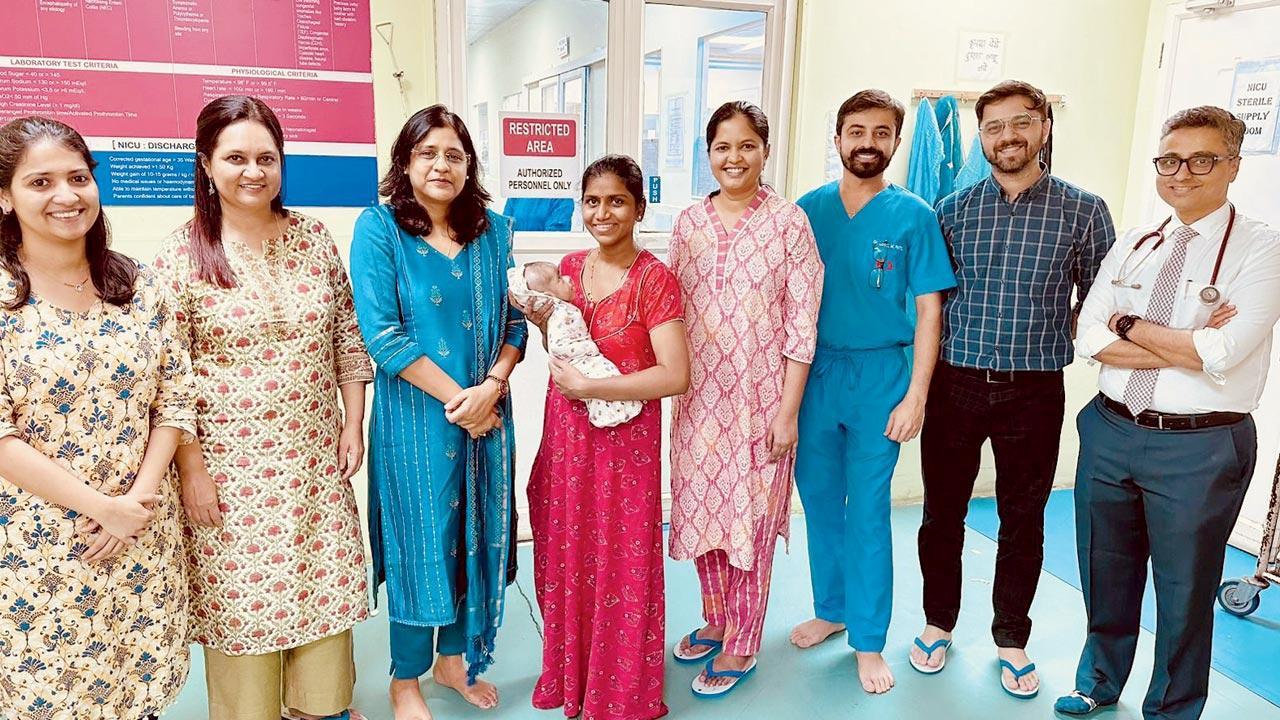According to Wadia doctors, the infant had undergone coil embolisation—a minimally invasive technique in which platinum coils were inserted into the aneurysm to prevent it from bursting

Infant with mother Aishwarya Jayesh Agare along with the team of doctors at Wadia children hospital in Parel
The doctors at Bai Jerbai Wadia Hospital successfully operated on a 19-day-old infant suffering from an intracranial aneurysm—a dangerous bulge in a brain blood vessel that could have potentially caused severe brain damage.
ADVERTISEMENT
The doctors at the hospital for children in Parel performed the complex procedure on Samarth Agare, believed to be the youngest patient in India to undergo this procedure.
According to the doctors, the patient had undergone coil embolisation—a minimally invasive technique in which platinum coils were inserted into the aneurysm to prevent it from bursting.
Jai Agare, the child’s father, a resident of Virar, said that Samarth developed a fever a day after he was born and was admitted to Apollo hospital in Badlapur. "He soon developed an infection, but the doctors could not identify the cause. They advised us to transfer him to Wadia hospital," Jai said.
At Wadia, Samarth's condition worsened, said the father, adding that he began vomiting, which doctors suspected was a reaction to the medication for his infection.
The hospital authorities said that the infant was put on oxygen support due to respiratory distress and had developed sepsis.
After keeping him for several days, a magnetic resonance imaging (MRI) scan was taken on day 16, which revealed a balloon-like bulge in a blood vessel in his brain, measuring “9.7 x 9.5 x 8.3 mm”—roughly the size of a large marble, said the hospital authorities.
The scan showed bleeding in the surrounding area, as the aneurysm had ruptured. "Such brain haemorrhages in children are extremely rare, and even rarer in newborns. This type of bleeding is called a subarachnoid haemorrhage," said Dr Rashmi Saraf, senior paediatric neurointerventional radiologist at King Edward Memorial Hospital, who also practises at Wadia.
Although the cause of the infection remained unclear despite multiple tests, the condition that followed was linked to the infection, said the doctor, adding that open neurosurgery was not feasible in this case because of the child’s age. "So, we opted for endovascular coiling, as it is less invasive," said Dr Saraf. "This procedure does not involve opening the brain. Instead, we access the arteries through the groin, navigate up to the aorta, and enter the brain’s arteries from there."
The child was closely watched and treated in the Neonatal Intensive Care Unit (NICU) and five days after the surgery, he was taken off the breathing machine and started breathing on his own.
“This marks a pivotal moment in paediatric interventional neuroradiology,” said Wadia hospital chief executive officer Dr Minnie Bodhanwala.
He said that the procedure emphasises the hospital's commitment to leveraging cutting-edge techniques and state-of-the-art facilities.
“Experts at Wadia have not only demonstrated advanced medical capabilities but also showcased their capacity to handle complex cases with compassion and care. The multidisciplinary team involved worked cohesively, applying years of experience to navigate this delicate situation,” Bodhanwala added.
Samarth was discharged by the end of July. “Dr Rashmi helped in understanding the process. We are still visiting the hospital for follow ups,” said the infant's father.
 Subscribe today by clicking the link and stay updated with the latest news!" Click here!
Subscribe today by clicking the link and stay updated with the latest news!" Click here!







